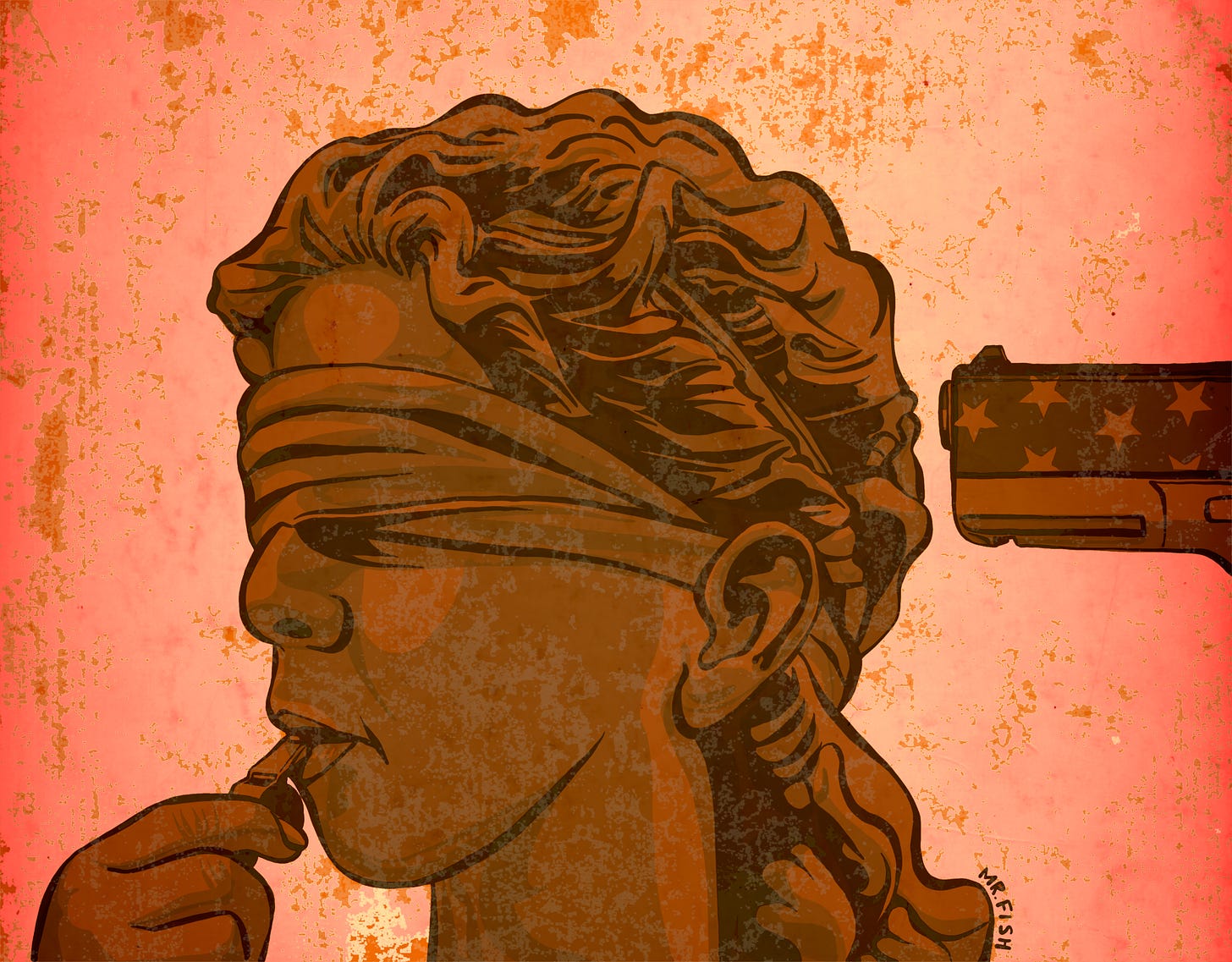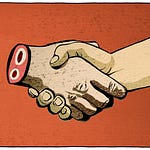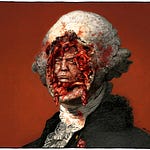Narrated by Eunice Wong
Text Originally published 07/31/2022
Pig and Whistle -by Mr. Fish
MARION, Illinois — Daniel Hale, dressed in a khaki uniform, his hair cut short and sporting a long, neatly groomed brown beard, is seated behind a plexiglass screen, speaking into a telephone receiver at the federal prison in Marion, Illinois. I hold a receiver on the other side of the plexiglass and listen as he describes his journey from working for the National Security Agency and the Joint Special Operations Task Force at Bagram Air Base in Afghanistan to becoming federal prisoner 26069-07.
Hale, a 34-year-old former Air Force signals intelligence analyst, is serving a 45 month prison sentence, following his conviction under the Espionage Act for disclosing classified documents about the U.S. military’s drone assassination program and its high civilian death toll. The documents are believed to be the source material for “The Drone Papers” published by The Intercept, on October 15, 2015.
These documents revealed that between January 2012 and February 2013, U.S. special operations drone airstrikes killed more than 200 people — of which only 35 were the intended targets. According to the documents, over one five-month period of the operation, nearly 90 percent of the people killed in airstrikes were not the intended targets. The civilian dead, usually innocent bystanders, were routinely classified as “enemies killed in action.”
You can see my interview with Hale’s attorney, Jesselyn Radack, here.
The terrorizing and widespread killing of thousands, perhaps tens of thousands, of civilians was a potent recruiting tool for the Taliban and Iraqi insurgents. The aerial attacks created far more hostile fighters than they eliminated and enraged many in the Muslim world.
Hale is composed, articulate and physically fit from his self-imposed regime of daily exercise. We discuss books he has recently read, including John Steinbeck’s novel East of Eden and Nicholson Baker’s Baseless: My Search for Secrets in the Ruins of the Freedom of Information Act, which explores whether the U.S. used biological weapons on China and Korea during World War II and the Korean War.
Hale is currently housed in the Communications Management Unit (CMU), a special unit that severely restricts and heavily monitors communications, including our conversation, and visitations. The decision by The Bureau of Prisons to lock Hale up in the most restrictive wing of a supermax prison ignores the recommendation of the sentencing Judge Liam O’Grady, who suggested that he be placed in a low-security prison hospital facility in Butner, North Carolina, where he could get treatment for his PTSD.
Hale is one of a few dozen people of conscience who have sacrificed their careers and their freedom to inform the public about government crimes, fraud and lies. Rather than investigate the crimes that are exposed and hold those who carried them out to account, the two ruling parties wage war on all who speak out.
These men and women of conscience are the lifeblood of journalism. Reporters cannot document abuses of power without them. The silence on the part of the press over Hale’s imprisonment, as well as the persecution and imprisonment of other champions of an open society, such as Julian Assange, is stunningly shortsighted. If our most important public servants, those with the courage to inform the public, continue to be criminalized at this rate, we will cement in place total censorship, resulting in a world where the abuses and crimes of the powerful are shrouded in darkness.
Barack Obama weaponized the Espionage Act to prosecute those who provided classified information to the press. The Obama White House, whose assault on civil liberties was worse than those of the Bush administration, used the 1917 Act, designed to prosecute spies, against eight people who leaked information to the press including Edward Snowden, Thomas Drake, Chelsea Manning, Jeffrey Sterling and John Kiriakou, who spent two-and-a-half years in prison for exposing the routine torture of suspects held in black sites.
Also under The Espionage Act, Joshua Schulte, a former CIA software engineer, was convicted on July 13, 2022 of the so-called Vault 7 leak, published by WikiLeaks in 2017, which revealed how the CIA hacked Apple and Android smartphones and turned internet-connected televisions into listening devices. He faces up to 80 years in prison. Assange, although he is not a U.S. citizen, and WikiLeaks is not a U.S.-based publication, was indicted by the Trump administration under the Act.
Obama used the Espionage Act against those who provided information to the press more than all previous administrations combined. He set a terrifying legal precedent, equating informing the public with spying for a hostile power. I published classified material when I was a reporter at The New York Times. It is a short step from criminalizing journalism to the imprisonment and murder of reporters, such as Jamal Khashoggi in the Saudi consulate in 2018 in Istanbul. While Assange was sheltering in the Ecuadorian Embassy in London, the CIA discussed kidnapping and assassinating him following the release of the Vault 7 documents.
The Espionage Act has been abused in the past. President Woodrow Wilson used it to throw socialists, including Eugene V. Debs, in prison for opposing America’s participation in World War I.
But not until the Trump administration was it turned directly on the press with the indictment of Assange.
Wholesale government surveillance, about which many charged under the Espionage Act tried to warn the public, includes surveillance of journalists. The surveillance of the press, along with those who attempt to inform the public by providing information to reporters, has largely shut down investigations into the machinery of power. The price of telling the truth is too costly.
Hale, trained in the army as a Mandarin linguist, was uneasy the moment he began working in the secretive drone program.
“I needed a paycheck,” he says of his work in the Air Force and later as a private contractor in the drone program, “I was homeless. I had nowhere else to go. But I knew it was wrong.”
While stationed at Fort Bragg, North Carolina, he took a week off in October 2011 to camp out in New York’s Zuccotti Park during the Occupy Wall Street movement. He wore his uniform — a gutsy act of open defiance for someone on active duty— and held up a sign that read, “Free Bradley Manning,” who had not yet announced her transition.
“I slept in the park,” he says. “I was there the morning [Mayor] Bloomberg and his girlfriend made the first attempt to clear the occupiers. I stood with thousands of protestors, including Teamsters and communications workers, who ringed the park. The police backed down. I learned later that while I was in the park, Obama ordered a drone strike in Yemen that killed Abdulrahman Anwar al-Awlaki, the 16-year-old son of the radicalized cleric Anwar al-Awlaki, killed by a drone strike two weeks earlier.”
Hale was deployed a few months later to Afghanistan’s Bagram Air Force Base.
He described his work in a letter to the judge:
In my capacity as a signals intelligence analyst stationed at Bagram Airbase, I was made to track down the geographic location of handset cell phone devices believed to be in the possession of so-called enemy combatants. To accomplish this mission required access to a complex chain of globe-spanning satellites capable of maintaining an unbroken connection with remotely piloted aircraft, commonly referred to as drones. Once a steady connection is made and a targeted cell phone device is acquired, an imagery analyst in the U.S., in coordination with a drone pilot and camera operator, would take over using information I provided to surveil everything that occurred within the drone’s field of vision. This was done, most often, to document the day-to-day lives of suspected militants. Sometimes, under the right conditions, an attempt at capture would be made. Other times, a decision to strike and kill them where they stood would be weighed.
The first time that I witnessed a drone strike came within days of my arrival to Afghanistan. Early that morning, before dawn, a group of men had gathered together in the mountain ranges of Patika province around a campfire carrying weapons and brewing tea. That they carried weapons with them would not have been considered out of the ordinary in the place I grew up, much less within the virtually lawless tribal territories outside the control of the Afghan authorities. Except that among them was a suspected member of the Taliban, given away by the targeted cell phone device in his pocket. As for the remaining individuals, to be armed, of military age, and sitting in the presence of an alleged enemy combatant was enough evidence to place them under suspicion as well. Despite having peacefully assembled, posing no threat, the fate of the now tea drinking men had all but been fulfilled. I could only look on as I sat by and watched through a computer monitor when a sudden, terrifying flurry of hellfire missiles came crashing down, splattering purple-colored crystal guts on the side of the morning mountain.
Since that time and to this day, I continue to recall several such scenes of graphic violence carried out from the cold comfort of a computer chair. Not a day goes by that I don’t question the justification for my actions. By the rules of engagement, it may have been permissible for me to have helped to kill those men — whose language I did not speak, whose customs I did not understand, and whose crimes I could not identify — in the gruesome manner that I did. Watch them die. But how could it be considered honorable of me to continuously have laid in wait for the next opportunity to kill unsuspecting persons, who, more often than not, are posing no danger to me or any other person at the time. Nevermind honorable, how could it be that any thinking person continued to believe that it was necessary for the protection of the United States of America to be in Afghanistan and killing people, not one of whom present was responsible for the September 11th attacks on our nation. Notwithstanding, in 2012, a full year after the demise of Osama bin Laden in Pakistan, I was a part of killing misguided young men who were but mere children on the day of 9/11.
Hale drifted after leaving the Air Force, dropped out of the New School where he had been attending college, and was lured back into operating drones in 2013 by the private defense contractor National Geospatial-Intelligence Agency where he worked as a political geography analyst between December 2013 and August 2014.
“I was making $ 80,000 a year,” he says into the receiver. “I had friends with college degrees who could not make that kind of money.”
Inspired by peace activist David Dellinger, Hale decided to become a “traitor” to “the American way of death.” He would make amends for his complicity in the killings, even at the cost of his freedom. He leaked 17 classified documents that exposed the high number of civilian deaths from drone strikes. He became an outspoken and prominent critic of the drone program.
Because Hale was charged under the Espionage Act, he was not permitted to explain his motivations to the court. He was also forbidden from providing evidence to the court that the drone assassination program killed and wounded large numbers of noncombatants, including children.
“Evidence of the defendant’s views of military and intelligence procedures would needlessly distract the jury from the question of whether he had illegally retained and transmitted classified documents, and instead convert the trail into an inquest of U.S. military and intelligence procedures,” government attorneys said in a motion at Hale’s trial.
“The defendant may wish for his criminal trial to become a forum on something other than his guilt, but those debates cannot and do not inform the core questions in this case: whether the defendant illegally retained and transferred the documents he stole,” the government motion continued.
Drones often fire Hellfire missiles equipped with an explosive warhead weighing about 20 pounds. A Hellfire variant, known as the R9X, carries an inert warhead. Instead of exploding, it hurls about 100 pounds of metal through a vehicle. The missile’s other feature includes six long blades tucked inside which deploy seconds before impact, shredding anything in front of it — including people.
Drones hover 24 hours a day in the skies over countries including Iraq, Somalia, Yemen, Pakistan, Syria and, before our defeat, Afghanistan. Operated remotely from Air Force bases as far away from the target sites as Nevada, drones fire ordinance that instantly and without warning obliterates homes and vehicles or kills clusters of people. Hale found the jocularity of the young drone operators, who treated the killings as if they were an enhanced video game, disturbing. Child victims of drone attacks were dismissed as “fun-sized terrorists.”
Those who survive drone strikes are often badly maimed, losing limbs, suffering severe burns and shrapnel wounds, and losing their vision and hearing.
In a statement he read at his sentencing on July 27, 2021, Hale said:“I think of the farmers in their poppy fields whose daily harvest will gain them safe passage from the warlords, who will, in turn, trade it for weapons before it is synthesized, repackaged, and re-sold dozens of times before it finds its way into this country and into the broken veins of our nation’s next opioid victim. I think of the women who, despite living their entire lives never once allowed to make so much as a choice for themselves, are treated as pawns in a ruthless game politicians play when they need a justification to further the killing of their sons & husbands. And I think of the children, whose bright-eyed, dirty faces look to the sky and hope to see clouds of gray, afraid of the clear blue days that beckon drones to come carrying eager death notes for their fathers.”
“As one drone operator put it,” he read in court, “‘Do you ever step on ants and never give it another thought?’ That’s what you’re made to think of the targets. They deserved it, they chose their side. You had to kill a part of your conscience to keep doing your job — ignoring the voice inside telling you this wasn’t right. I, too, ignored the voice inside as I continued walking blindly towards the edge of an abyss. And when I found myself at the brink, ready to give in, the voice said to me, ‘You, who had been a hunter of men, are no longer. By the grace of God you’ve been saved. Now go forth and be a fisher of men so that others might know the truth.’”
It was, ironically, the election of Obama that encouraged Hale to join the Air Force.
“I thought Obama, who as a candidate opposed the war in Iraq, would end the wars and lawlessness of the Bush administration,” he says.
However, a few weeks after he took office, Obama approved the deployment of an additional 17,000 troops to Afghanistan, where 36,000 U.S. troops and 32,000 NATO troops were already deployed. By the end of the year, Obama increased troop levels in Afghanistan again by 30,000, doubling U.S. casualties. He also massively expanded the drone program, raising the number of drone strikes from several dozen the year before he took office to 117 by his second year in office. By the time he left office, Obama had presided over 563 drone strikes that killed approximately 3,797 people, many of whom were civilians.
Obama authorized “signature strikes” allowing the CIA to carry out drone attacks against groups of suspected militants without getting positive identification. His administration approved “follow-up” or “double-tap” drone strikes, which deployed drones to strike anyone who assisted those injured in the initial drone strike. The Bureau of Investigative Journalists reported in 2012 that “at least 50 civilians were killed in follow-up strikes when they had gone to help victims,” during Obama’s first three years in office. Additionally, “more than 20 civilians have also been attacked in deliberate strikes on funerals and mourners” the report read. Obama expanded the footprint of the drone program in Pakistan, Somalia and Yemen, and established drone bases in Saudi Arabia and Turkey.
“There are several such lists, used to target individuals for different reasons,” Hale writes in an essay titled, “Why I Leaked the Watchlist Documents,” originally published anonymously in May 2016 in the book The Assassination Complex: Inside the Government’s Secret Drone Warfare Program by Jeremy Scahill and the staff of The Intercept.
“Some lists are closely kept; others span multiple intelligence and local law enforcement agencies,” Hale writes in the essay. “There are lists used to kill or capture supposed ‘high-value targets, ’ and others intended to threaten, coerce, or simply monitor a person’s activity. However, all the lists, whether to kill or silence, originate from the Terrorist Identities Datamart Environment (TIDE), and are maintained by the Terrorist Screening Center at the National Counterterrorism Center. The existence of TIDE is unclassified, yet details about how it functions in our government are completely unknown to the public. In August 2013 the database reached a milestone of one million entries. Today, it is thousands of entries larger and is growing faster than it has since its inception in 2003.”
The Terrorist Screening Center, he writes, not only stores names, dates of birth, and other identifying information of potential targets but also stores “medical records, transcripts, and passport data; license plate numbers, email, and cell-phone numbers (along with the phone’s International Mobile Subscriber Identity and International Mobile Station Equipment Identity numbers); your bank account numbers and purchases; and other sensitive information, including DNA and photographs capable of identifying you using facial recognition software.”
Suspects’ data is collected and pooled by the intelligence alliance formed by Australia, Canada, New Zealand, the United Kingdom and the United States, known as the Five Eyes. Each person on the list is assigned a TIDE personal number, or TPN.
“From Osama bin Laden (TPN 1063599) to Abdulrahman Awlaki (TPN 26350617), the American son of Anwar al Awlaki, anyone who has ever been the target of a covert operation was first assigned a TPN and closely monitored by all agencies who follow that TPN long before they were eventually put on a separate list and extrajudicially sentenced to death,” Hale wrote.
As Hale exposed in the leaked documents, the more than one million entries in the TIDE database include about 21,000 U.S. citizens.
“When the President gets up in front of the nation and says they are doing everything they can to ensure there is near certainty there will be no civilians killed, he is saying that because he can’t say otherwise, because anytime an action is taken to finish a target there is a certain amount of guesswork in that action,” Hale says in the award-winning documentary “National Bird,” a film about whistleblowers in the U.S. drone program who suffered moral injury and PTSD. “It’s only in the aftermath of any kind of ordinance being dropped that you know how much actual damage was done. Oftentimes, the intelligence community is reliant, the Joint Special Operations Command, the CIA included, is reliant on intelligence coming afterwards that confirms that who they were targeting was killed in the strike, or that they weren’t killed in that strike.”
“The people who defend drones, and the way they are used, say they protect American lives by not putting them in harm’s way,” he says in the film. “What they really do is embolden decision makers because there is no threat, there is no immediate consequence. They can do this strike. They can potentially kill this person they are so desperate to eliminate because of how potentially dangerous they could be to the U.S. But if it just so happens that they don’t kill that person, or some other people involved in the strike get killed as well, there are no consequences for it. When it comes to high-value targets, [in] every mission you go after one person at a time, but anybody else killed in that strike is blankly assumed to be an associate of the targeted individual. So as long as they can reasonably identify that all of the people in the field view of the camera are military-aged males, meaning anybody who is believed to be age 16 or older, they are a legitimate target under the rules of engagement. If that strike occurs and kills all of them, they just say they got them all.”
Drones, he says, make remote killing “easy and convenient.”
On August 8, 2014, the FBI raided Hale’s home. It was his last day of work for the private contractor. Two FBI agents, one male and one female, shoved their badges in his face when he opened the door. About two dozen agents, pistols drawn, many wearing body armor, followed behind. They photographed and ransacked every room. They confiscated all his electronics, including his phone.
He spent the next five years in limbo. He struggled to find work, fought off depression and contemplated suicide. In 2019, the Trump administration indicted Hale on four counts of violating the Espionage Act and one count of theft of government property. As part of a plea deal, he pled guilty to one count of violating the Espionage Act.
“I am here to answer for my own crimes and not that of another person,” he said at his sentencing. “And it would appear that I am here today to answer for the crime of stealing papers, for which I expect to spend some portion of my life in prison. But what I am really here for is having stolen something that was never mine to take: precious human life. For which I was well-compensated and given a medal. I couldn’t keep living in a world in which people pretended things weren’t happening that were. My consequential decision to share classified information about the drone program with the public was a gesture not taken lightly, nor one I would have taken at all if I believed such a decision had the possibility of harming anyone but myself. I acted not for the sake of self-aggrandizement but that I might some day humbly ask forgiveness.”
I know a few Daniel Hales. They made my most important reporting possible. They enabled truths to be told. They held the powerful accountable. They gave a voice to the victims. They informed the public. They called for the rule of law.
I sit across from Hale and wonder if this is the end, if he, and others like him, will be completely silenced.
Hale’s imprisonment is a microcosm of the vast gulag being constructed for all of us.













Share this post